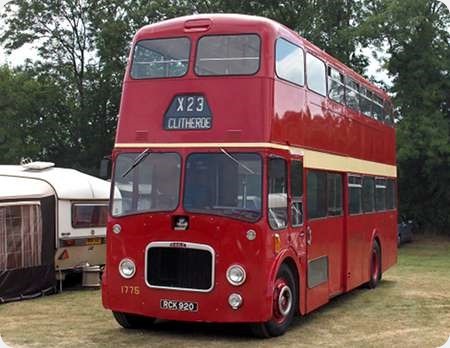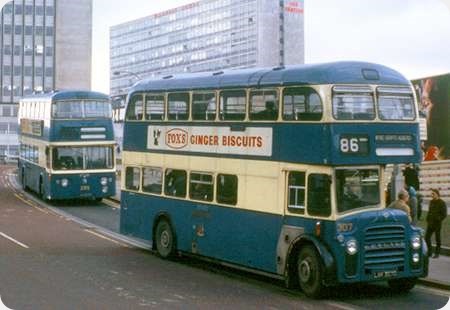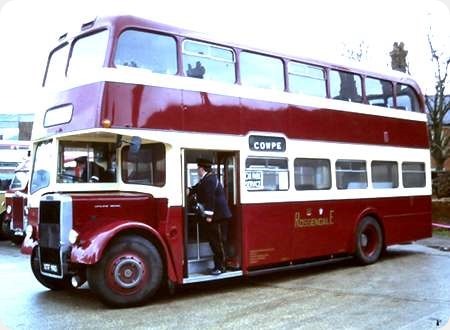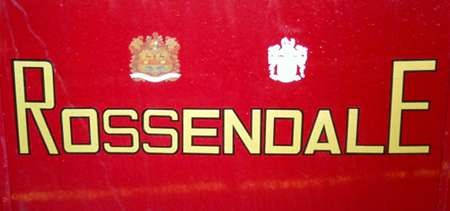
Ribble Motor Services
1962
Leyland Titan PD3/5
Metro-Cammell FH41/31F
In 1956 the UK maximum legal length for double deck buses was extended to 30 ft, and Leyland quickly responded with the PD3 chassis, essentially an elongated version of the PD2. Ribble ordered a fleet of 105 synchromesh gearbox PD3/4 machines distinguished by handsome Burlingham FH41/31F bodywork featuring a neatly designed full width front end. These entered service in 1958, but Ribble then tried its hand with the then very new and novel Leyland Atlantean design, taking 100 examples in 1959/60. All operators of the early Atlantean experienced a number of teething troubles, and Ribble, while continuing to favour the Atlantean for future orders, hedged its bets by partially returning to the more dependable PD3 for some of its 1961-63 deliveries. The bodywork was again FH41/31F, but this time of the aesthetically less appealing (to my eye, anyway) Orion style by Metro-Cammell . These later machines, which totalled 131 in number, were equipped with pneumocyclic gearboxes, making them type PD3/5. No.1775, RCK 920 was delivered in 1962 and operated in the Liverpool/Bootle and Carlisle localities until its withdrawal in 1981, when it was subsequently acquired for preservation. At some time in the years following, 1775’s pneumocyclic gearbox failed and was replaced by a synchromesh unit, but, when, in 2010, the vehicle passed into the hands of its current owners, the Ribble Vehicle Preservation Trust, the pneumocyclic box was repaired and refitted, bringing the bus back up to its original condition. In the picture above, 1775 is seen at the Wansford, Cambridgeshire, premises of the Nene Valley Railway on 8 July 2006 where I encountered it entirely unexpectedly.
A YouTube video of a ride on this bus may be found here:- at this link
Photograph and Copy contributed by Roger Cox
22/08/17 – 06:32
Although rather plain I always thought these were quite attractive vehicles. The proportions seem to sit right and the livery suits the lines of the bodywork very well. Dignified is the way I would sum it up which is more than can be said for the horrors seen on most modern vehicles.
Philip Halstead
22/08/17 – 06:33
The change away to a synchro box was done when owned by Gerald Boden (who owned a B1+Class 40). From my memory he chose to do it as it would have been cheaper to repair the semi auto.
Roger Burdett
23/08/17 – 06:17
The almost only one-coloured livery hardly favours the body shape, Philip. I can see an improvement in Southdown livery. Oops, it must be the sort-of Queen Mary shape that reminded me of that!
Chris Hebbron
25/08/17 – 06:52
I wondered if Roger Cox or Roger Burdett can shed any light on the original gearboxes (or their flywheels) that were at first originally fitted to these Ribble PD3’s (and for that matter the fully fronted Bolton PD3’s).
When new, at idle there was a most musical tinny mechanical sound that soon disappeared once power was applied, I think they had a mechanical flywheel then. Bolton and later Ribble soon changed them to the fluid flywheel, which I understand gave a better service life – but no music! Hope someone in the ‘know’ might be able to offer enlightenment.
Mike Norris
25/08/17 – 09:36
I believe you are referring to the centrifugal clutch which I suspect was intended to be more efficient than a fluid flywheel. I only had very limited experience of it on a Bolton bus and simply remember an awful racket when the bus was in idle, not something I would describe as music at all.
David Beilby
25/08/17 – 09:37
Cannot shed any light except to speculate it was a body vibration due to harmonics.
Maybe someone from Ribble Group can enlighten if the switch back to a stick box has re-introduced the sound
Roger Burdett
25/08/17 – 09:38
I think that "jingling noise" was symptomatic of a centrifugal clutch, which was an attempt to provide a degree of automatic change, but without the drag and therefore fuel consumption penalty of a fluid flywheel.However I could be wrong.
James Freeman
26/08/17 – 07:13
I’ve noticed in several posts reference to ‘synchromesh’ gearboxes (as above) but am I right in thinking that they were only synchromesh on third and fourth gears? On every Southdown Leopard and Queen Mary I drove that was the format but may have differed elsewhere?
Nick Turner
26/08/17 – 07:14
This page seems to confirm that these Titans were initially fitted with centrifugal clutches:- www.flickr.com/photos/ Several operators tried out the centrifugal coupling to improve fuel consumption – the fluid flywheel could never attain 100% drive efficiency – but transmission snatch and maintenance problems meant that the fluid flywheel reigned supreme until the arrival on the psv scene of the multi stage torque converter gearbox.
Roger Cox
26/08/17 – 07:14
The Wigan PD3’s which were pneumo-cyclic also made this noise. Wigan went back to manual gearboxes for their later PD2’s so perhaps there was some dissatisfaction with the semi-auto transmission.
Philip Halstead
27/08/17 – 07:01
I seem to recall there was another stage of development when centrifugal shoes were included in the fluid flywheel so that it locked up at a suitable speed. I can’t recall technical details of the Ribble/MCW PD3 but know they seemed to perform very well up to the bitter end of TMO in Merseyside.
PS> The Captcha code for this post is PD3A!
Geoff Pullin
27/08/17 – 07:02
The PD2 was initially supplied with the GB63 four speed gearbox that had synchromesh on second, third and top, bottom gear being simply constant mesh. Unfortunately the second gear synchro set up gave some trouble in that engagement was often strongly baulked. Geoffrey Hilditch records examples of the resistance to engagement being so severe that gear levers were snapped off by the over enthusiastic pressures being applied by desperate drivers. Leyland then offered the GB83 box in which the second gear synchromesh was eliminated, and this continued to be available after the second gear synchro problems of the CB63 box were sorted out. All the PD2/PD3 buses I drove in Halifax had synchro on second gear.
Roger Cox
29/08/17 – 06:38
For those who like classic liveries like this, there’s news from Arriva. Their new universal bus livery is a simple Bradford blue, it seems: not clear to me how many extra bits or brandings can be added or where, but others may have more intimate knowledge. It does look if all the fussy skirts and linings may have gone, but what about the odd flash? After First, this is a relief!
Joe
22/07/18 – 06:20
To confirm what has been discussed about the PD3’s with the semi-auto g/box the Fleet nos starting with 1700 were all fitted with the Centrifugal Clutch and the fleet nos starting with 1800 were all fitted with the Fluid Flywheel.
The Centrifugal Clutch used to rattle when the engine was on tickover as the toggles and pins were worn, as when they were new they used to whine until the clutch engaged.
Norman Johnstone




